 |
|||||||||||||||||||||||||||||||||||||||||||||||||||||||||||||||||
ACO Drain
|
 |
||||||||||||||||||||||||||||||||||||||||||||||||||||||||||||||||
hh
|
|||||||||||||||||||||||||||||||||||||||||||||||||||||||||||||||||
Grated Pits |
|
 |
Grated Trench Drainage |
On level pavements, can be used to contain spills or restrict runoff
|
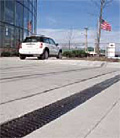 |
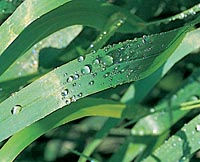 Water Sensitive Urbane Drainage Design (WSUD)
Water Sensitive Urbane Drainage Design (WSUD)Sustainable drainage is an element of the ‘Hydrological Cycle’. It is the collection of rainwater, its treatment and, ultimately, its reuse. The process involves capturing water run-off, that may or may not contain pollutants, so it can be dealt with in a controlled manner. The water can then be treated, stored for future use, or transported to receiving waterways. This transfer of water should come at low cost, and cause minimal damage and danger to the environment.
Surface drainage can be used where rainwater has collected on paved areas for the ‘capture’ part of this process.
Grated trench drains are ideal for the capture and collection of storm water run-off. They form a barrier to prevent rainwater run-off flowing onto the soft landscaping where collection is more difficult. This is of particular importance if the risk of contamination is high, such as in highway and petrol station applications. ACO provides a wide range of trench drains to meet the hydraulic needs of any WSUD design.
Drainage system comparison
Whether frequent light rainfall or occasional heavy downpours, surface drainage is necessary to prevent damage to pavement or property, and reduces safety hazards caused by ponding. Methods for dealing with surface drainage are:
- Grated pit & pipe system – point drainage (Figure 1.) or
- Grated trench drains (Figure 2.), which can be further categorised into:
a. Cast in-situ trench drains
b. Precast modular trench drains (ACO Drain )
)
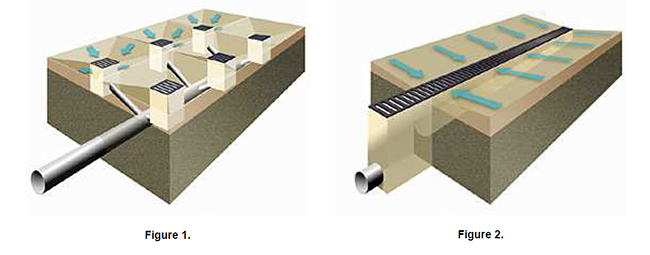
In 2014, a report was prepared by an independent quantity surveyor, Rider Levett Bucknall, to compare the installation costs of the three alternative surface drainage methods mentioned above for the carpark of the Aquatic Centre at Homebush, NSW.
Cost Comparison Results
| 1. Cast in-situ trench drains 2. Grated pit & pipe system 3. ACO Drain |
$393,000 $377,000 $340,000 |
(4% cheaper than cast in-situ trench drains) (13% cheaper than cast in-situ trench drains) |
The ACO Drain![]() option was determined to be cheaper than the cast in-situ trench drains and grated pit & pipe
option was determined to be cheaper than the cast in-situ trench drains and grated pit & pipe
system. Click here for further information and a breakdown of all costs
Choosing Trench Drainage
 When choosing a grated trench drain, the following
factors should be considered:
When choosing a grated trench drain, the following
factors should be considered:
- Hydraulic Performance - how much liquid is to be collected and removed.
- Application - the issues relating to location of the drain.
These factors should be addressed regardless of whether a modular channel system or cast-in-situ grated trench is used.
 |
1. Hydraulic Performance
The volume of liquid the grated trench drain collects and carries in a given time period. |
Important factors include:
|
||||||||||
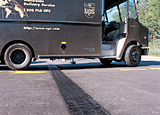 |
Application 2a) Loading Loading refers to any foot or vehicular traffic being applied to the grated trench drain. Load standards are a tool to enable comparison of products by providing an independent measurement scale. |
Important factors include:
|
||||||||||
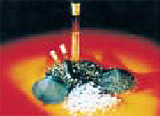 |
Application 2b) Durability To ensure long life, products must be carefully selected and installed correctly. An investigation of the application’s environment is recommended to identify any chemicals or other corrosive elements that may affect material choices. |
Important factors include:
|
||||||||||
 |
Application 2c) User requirements There is often more than one channel, grate and locking option that will meet hydraulic, loading and chemical resistance needs. User requirements are application specific and are determined by either design preference or legal obligations. |
Important factors include:
|
||||||||||
'V' profile channels
'V' profile channels - faster flow, less maintenance
HOW THE SHAPE OF A TRENCH DRAIN AFFECTS HYDRAULIC PERFORMANCE
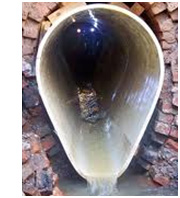 Stormwater runoff, particularly from peak flows needs adequate drainage to minimise the hazards associated with excessive surface water.
Stormwater runoff, particularly from peak flows needs adequate drainage to minimise the hazards associated with excessive surface water.
The internal profile of the flow section has a major influence on the hydraulic performance of trench drains. This is why ACO’s ‘V’ profile Polycrete![]() Channels have been developed on the back of the same drainage principle used for decades in the design of sewers with "egg-shaped" profiles.
Channels have been developed on the back of the same drainage principle used for decades in the design of sewers with "egg-shaped" profiles.
‘V’ profile channels in combination with the smooth surface of polymer concrete
produce a hydraulically efficient trench drain.
Trench drains are sized to capture, carry and discharge the flows from a design storm event which can occur on average 1 in 10, 20, 50 or 100 years. For the majority of its service life, however, the trench drain will only need to remove very small amounts of runoff on wet days. It is for this purpose, the ‘V’ profile channels outperforms the traditional ‘U’ shaped or rectangular shaped profiles.
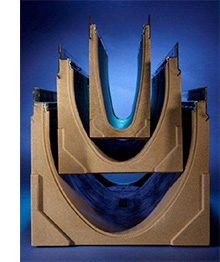 During minor rainfall, the lower narrower part of the ‘V’ profile channel ensures high liquid velocities. The high velocities originate from a high depth of water which can only be produced by ‘V’ profile channels. In contrast, ‘U’ shaped or rectangular shaped channels allows only for liquids to travel at lower depths and therefore at lower velocities.
During minor rainfall, the lower narrower part of the ‘V’ profile channel ensures high liquid velocities. The high velocities originate from a high depth of water which can only be produced by ‘V’ profile channels. In contrast, ‘U’ shaped or rectangular shaped channels allows only for liquids to travel at lower depths and therefore at lower velocities.
Fluid mechanics can further explain this phenomenon, the greater the cross-sectional area in comparison to the wetted perimeter, the more freely flowing the stream will be, this is because less of the water is in proximity to the frictional bed. So as hydraulic radius increases so will velocity. Furthermore, in combination with the smooth finish of polymer concrete with a ‘Mannings coefficient’ of 0.011, this results in less resistance thereby preserving the high velocities.
Higher velocity liquids will produce a better self-cleaning effect which is extremely important because it clears the drain and ensures the full drainage cross section is available for that major storm event which produces peak flows.
Click here for further details and PDF version of this page.
Sloped channels
 Sloped channels - For optimum hydraulic performance
Sloped channels - For optimum hydraulic performance
HOW DOES SLOPE IN A TRENCH DRAIN AFFECT HYDRAULIC PERFORMANCE
Draining large flat pavements can be a challenge. Poorly designed drainage systems are not only ineffective at clearing surface water quickly, but can be difficult to maintain and cause slip hazards from ponding. A good design along with a hydraulically efficient drainage system can eliminate these hazards and provide a long lasting, durable solution that performs as intended.
How to achieve optimum hydraulic efficiency?
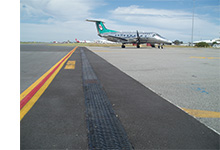 There are a wide range of surface drainage systems for various applications, but when it comes to discharging surface water efficiently, it depends on how the trench drains are configured. These systems are designed to collect surface flows through the grate into channels that transport the flows to a point where it discharges into an underground pipe system or culvert. One key factor influencing the hydraulic performance of surface drainage systems is gravity and therefore the effect of ground slope and built-in slopes within the trench drain is critical.
There are a wide range of surface drainage systems for various applications, but when it comes to discharging surface water efficiently, it depends on how the trench drains are configured. These systems are designed to collect surface flows through the grate into channels that transport the flows to a point where it discharges into an underground pipe system or culvert. One key factor influencing the hydraulic performance of surface drainage systems is gravity and therefore the effect of ground slope and built-in slopes within the trench drain is critical.
How does the slope affect hydraulic performance?
As the degree of slope (fall) along the channel invert increases, the velocity of the flow within the trench drain will also increase resulting in a more hydraulically efficient trench drain. The slope can be introduced into the design of the trench drain by one or a combination of the following:
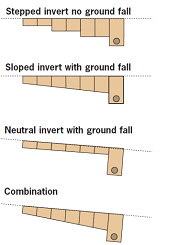 |
|
 Introducing a stepped configuration has the least positive impact on a trench drain’s hydraulic performance. This is because on flat level pavements, particularly with long runs, velocities are limited by significant lengths of neutral channels with no slope (fall).
Introducing a stepped configuration has the least positive impact on a trench drain’s hydraulic performance. This is because on flat level pavements, particularly with long runs, velocities are limited by significant lengths of neutral channels with no slope (fall).
In comparison, drainage runs comprising continuous sloped channels with built-in falls allow for positive drainage with greater flow velocities for optimum hydraulic performance.
Click here for further details and PDF version of this page.


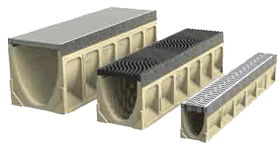 300mm internal width
300mm internal width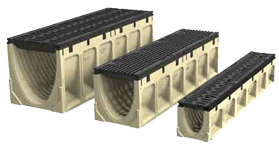 300mm
internal width
300mm
internal width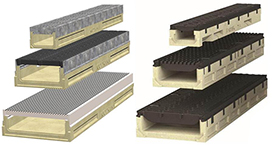



 ACO RESOURCES
ACO RESOURCES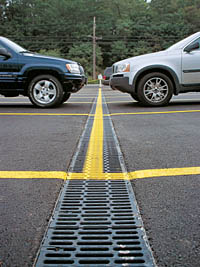 Surface drainage is important. Whether frequent light rainfall or occasional heavy downpours, surface drainage is necessary. To prevent damage to pavement or property, and reduces safety hazards caused by ponding. Surface drainage is designed to:
Surface drainage is important. Whether frequent light rainfall or occasional heavy downpours, surface drainage is necessary. To prevent damage to pavement or property, and reduces safety hazards caused by ponding. Surface drainage is designed to: